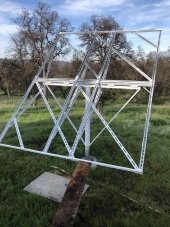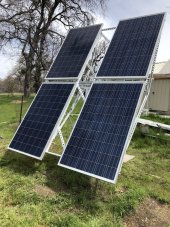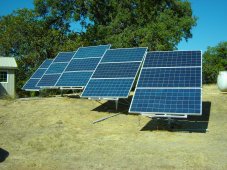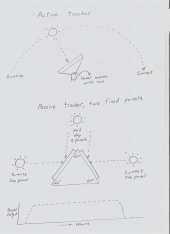You are using an out of date browser. It may not display this or other websites correctly.
You should upgrade or use an alternative browser.
You should upgrade or use an alternative browser.
Home made tracker ideas?
- Thread starter kanelr
- Start date
MichaelK
Solar Wizard
These are some of my manual tracker designs. I go out at ~7:30am, 9:30am 11:30am, and again at about 1:30pm to pull the array frame around by hand. I call it hillbilly solar tracking! Made out of mostly full-channel unistruts, with schedule 40 pipe sunk in concrete.
Attachments
Nobodybusiness
Collecting the leftovers of the Great Sky Reactor.
Was going to considering Linear actuators are actually pretty cheap but so are panels also so just got more panels...Has anyone made a home made tracker? old school satellite disk rotators, tv antenna rotors, the R.A. motor from a good telescope, what?
If you're space limited good idea..
MichaelK
Solar Wizard
Just going outside and making minor adjustments on the fly, I can measure improvements in the range of ~25% or so. Looking at it another way though, but rotating East to West over the course of the day, I've measured approximately 90% increase in production.Are there any numbers as to how much it increases output versus fixed solar panels that ar almost flat or something like a 40 degrees angle?
I’ve made 2 home made trackers. Each tracker carries 2kW of panels. The frames are home made from steel tubing and they are both single axis trackers. 36v linear actuators normally used for large satellite dishes were used to manipulate the array. I designed and built the electronics. The first was analog based and for the second an arduino was used. For sensors, 2 small PV panels back to back facing east-west were used and the system adjusts the array position until the power output from the 2 panels are equal. Initially I used relays to drive the actuator but for reasons that I never got to the bottom of, the relays would fail after a few months so they were swapped out for MOSFET’s in a H configuration. Never had a problem since.
As for output, they harvest between 30% and 40% more energy during the summer. I live in southern Spain so we get dawn ’til dusk sun in the summer which, I think, is why the tracker makes such a big difference.
As for output, they harvest between 30% and 40% more energy during the summer. I live in southern Spain so we get dawn ’til dusk sun in the summer which, I think, is why the tracker makes such a big difference.
There is a link on this site somewhere that helps find the “best” angles pretty painlessly, including yield, sort of.Are there any numbers as to how much it increases output versus fixed solar panels that ar almost flat or something like a 40 degrees angle?
MichaelK
Solar Wizard
I just took a 12" length of PVC pipe and placed it in front of the panel. Rotate the pipe around untill you see the sun shining through the central hole. That is when the panel is perfectly perpendicular.There is a link on this site somewhere that helps find the “best” angles pretty painlessly, including yield, sort of.
chrisski
Solar Boondocker
- Joined
- Aug 14, 2020
- Messages
- 5,174
I see similar results on my nine hundred watts of panels I move throughout the day.Just going outside and making minor adjustments on the fly, I can measure improvements in the range of ~25% or so. Looking at it another way though, but rotating East to West over the course of the day, I've measured approximately 90% increase in production.
Warpspeed
Solar Wizard
Its not as critical as many people think.
Imagine you are the sun looking down on your solar panel.
If its facing you directly, you will see 100% of the whole surface area.
If the panel is completely edge on, you (the sun) see no active panel area at all.
If the panel is tilted away from the sun by say ten or twenty degrees it hardly makes much difference.
But when you go past about forty degrees, the output falls away very quickly.
So a tracker can help a lot, but it does not need to track absolutely perfectly to give really good results.
A passive tracker works pretty well too, particularly in summer, where the sun rises due east, moves directly overhead, and sets due west.
If fixed panels are installed east/west tilted at sixty degrees, you will get a very constant output all day long, without the mid day peak.
This configuration is also very good for wind loading, as its inherently very strong, and wind cannot get under the panels to create a lifting force.
Ideal for a flat garage roof.
These are mounted on a bolted together, sixty degree equilateral triangular frame.
Imagine you are the sun looking down on your solar panel.
If its facing you directly, you will see 100% of the whole surface area.
If the panel is completely edge on, you (the sun) see no active panel area at all.
If the panel is tilted away from the sun by say ten or twenty degrees it hardly makes much difference.
But when you go past about forty degrees, the output falls away very quickly.
So a tracker can help a lot, but it does not need to track absolutely perfectly to give really good results.
A passive tracker works pretty well too, particularly in summer, where the sun rises due east, moves directly overhead, and sets due west.
If fixed panels are installed east/west tilted at sixty degrees, you will get a very constant output all day long, without the mid day peak.
This configuration is also very good for wind loading, as its inherently very strong, and wind cannot get under the panels to create a lifting force.
Ideal for a flat garage roof.
These are mounted on a bolted together, sixty degree equilateral triangular frame.
Attachments
@Warpspeed What do you mean by a passive tracker, and how does the one in the picture work?
Warpspeed
Solar Wizard
Nothing moves (its totally passive) but it works equally well exposing the same active area of solar to the sun from sunrise right through the day to sunset.
It works as if the panels actually did physically move and track the sun.
Only disadvantage you only get half the total rated panel energy.
At sunrise the east facing panel produces just about full rated power, the west panel nothing.
At mid day both contribute about 50% each, giving the same as if one panel was working fully facing the sun.
At sunset the west panel produces full rated power, the east panel nothing.
The geometry is such, that the power received stays almost constant throughout the whole day, without requiring anything to physically move.
But you will only get say 1Kw constant out of two banks of 1Kw rated panels.
In some circumstances that can be a very worthwhile tradeoff.
In mid summer here we have about 17 hours of daylight and around 7 hours of dark.
As soon as the sun rises above the horizon, power goes from zero to full in about twenty minutes. Solar output sits at constant full power for about sixteen hours, then quickly drops to zero, again in about twenty minutes. Assuming a clear blue sky all day of course.
That is pretty much what a moving tracker is supposed to do. But this does essentially the same thing without moving.
And it does it without requiring any troublesome moving machinery.
Mechanically tracking a very few panels is not a big deal.
Tracking a few dozen panels wold be quite a project !
This is well worth thinking about for larger systems.
It works as if the panels actually did physically move and track the sun.
Only disadvantage you only get half the total rated panel energy.
At sunrise the east facing panel produces just about full rated power, the west panel nothing.
At mid day both contribute about 50% each, giving the same as if one panel was working fully facing the sun.
At sunset the west panel produces full rated power, the east panel nothing.
The geometry is such, that the power received stays almost constant throughout the whole day, without requiring anything to physically move.
But you will only get say 1Kw constant out of two banks of 1Kw rated panels.
In some circumstances that can be a very worthwhile tradeoff.
In mid summer here we have about 17 hours of daylight and around 7 hours of dark.
As soon as the sun rises above the horizon, power goes from zero to full in about twenty minutes. Solar output sits at constant full power for about sixteen hours, then quickly drops to zero, again in about twenty minutes. Assuming a clear blue sky all day of course.
That is pretty much what a moving tracker is supposed to do. But this does essentially the same thing without moving.
And it does it without requiring any troublesome moving machinery.
Mechanically tracking a very few panels is not a big deal.
Tracking a few dozen panels wold be quite a project !
This is well worth thinking about for larger systems.
Attachments
Last edited:
Warpspeed
Solar Wizard
This is nothing new, and I did not invent the name.
But I did build one several years ago, and very happy with the results.
Its definitely not for everyone, but at least, it's something that people should at least be aware of.
But I did build one several years ago, and very happy with the results.
Its definitely not for everyone, but at least, it's something that people should at least be aware of.
conquistador
New Member
- Joined
- Sep 21, 2021
- Messages
- 108
17hours, you must be quite high up North. So they are positioned East West, which means in the winter, no south facing panels for the few hours of sun you will get. How does this perform in the winter? Or do you not care and count the winter at all because of bad weather and no sun?In mid summer here we have about 17 hours of daylight and around 7 hours of dark.
Warpspeed
Solar Wizard
Quite a long way south in fact.
You are right, the east west panels are pretty terrible in winter when the sun is very low in the northern sky.
But I have a much larger north facing array that covers that situation.
One thing I have noticed, when its grey and gloomy with total cloud cover, the soft grey light is very diffused, and it does not matter which way solar panels face.
The output is still pitifully low, but any exposed panels work equally well, and the more panels you have, whatever direction they face will contribute something in a dull grey sky. So the east west panels still contribute something, but not much on total cloud days.
The problem with the main north facing panels in mid summer is that the sun actually rises and sets behind the panels. They take at least an hour until they get going in the morning, than gain very slowly, producing a MASSIVE short duration mid day power peak. By that time the battery has usually fully recharged, and all that available power is totally wasted.
The east west panels start producing power early and last through almost to sunset, so that is very beneficial for initial battery charging and airconditining in late afternoon.
You are right, the east west panels are pretty terrible in winter when the sun is very low in the northern sky.
But I have a much larger north facing array that covers that situation.
One thing I have noticed, when its grey and gloomy with total cloud cover, the soft grey light is very diffused, and it does not matter which way solar panels face.
The output is still pitifully low, but any exposed panels work equally well, and the more panels you have, whatever direction they face will contribute something in a dull grey sky. So the east west panels still contribute something, but not much on total cloud days.
The problem with the main north facing panels in mid summer is that the sun actually rises and sets behind the panels. They take at least an hour until they get going in the morning, than gain very slowly, producing a MASSIVE short duration mid day power peak. By that time the battery has usually fully recharged, and all that available power is totally wasted.
The east west panels start producing power early and last through almost to sunset, so that is very beneficial for initial battery charging and airconditining in late afternoon.
StuartV
New Member
Here's mine! made out of 2 pallets, wheels from amazon, timber is 38x63mm stud planks, with single slot shelving bars as axles! Bit of strapping screwed underneath, so I can lift and move them around the garden (there are 2 of them).
I have them stood near upright in the morning on the left side of the garden as the sun is low in the morning. then near flat during the day in the middle of the garden, then near upright on the right hand side in the evening.
They each have a 340W Trinia panel on them. Each has a spare block underneath so I can do the SPAT during the day to find the right angle ?
I have them stood near upright in the morning on the left side of the garden as the sun is low in the morning. then near flat during the day in the middle of the garden, then near upright on the right hand side in the evening.
They each have a 340W Trinia panel on them. Each has a spare block underneath so I can do the SPAT during the day to find the right angle ?
Attachments
Similar threads
- Replies
- 2
- Views
- 369
- Replies
- 20
- Views
- 2K
- Replies
- 13
- Views
- 724










